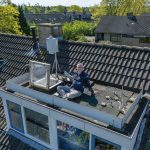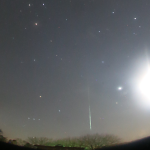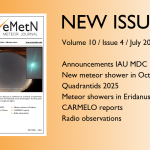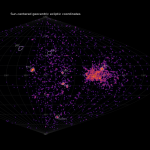Abstract: A summary of the activity of the CAMS BeNeLux network during the month of May 2021 is presented. 4759 multi-station meteors were collected which resulted in 1503 orbits during 28 nights with a maximum of 82 operational cameras available at 26 different CAMS stations.
1 Introduction
The first weeks of May offer nice levels of meteor activity with the eta Aquariids in the early morning hours. The last couple of weeks get shorter nights while the meteor activity decreases to the lowest level of the year. With short nights, low activity and often poor weather this time of the year it remains a challenge to collect orbits. May 2020 was exceptionally favorable, but what would 2021 bring?
2 May 2021 statistics
May 2021 was an exceptional cold and rainy month with a lot of cloudy sky and therefore rather unfavorable weather for meteor work. Only 6 nights resulted in 100 or more orbits (against 18 in 2020 and 7 in 2019). Only three nights remained without any orbits (2 nights in 2020 and 2019). The best night of all was the last night of the month, May 31–June 1 with 151 orbits. During most nights multiple station events were recorded during clear spells at least where the cameras were kept capturing all nights.
In total 4759 multi-station meteors were recorded (against 11584 in May 2020 and 5886 in 2019), good for 1503 orbits (against 3226 in 2020 and 1825 in May 2019). This is the poorest result for this month since 2016 when the network had significant less operational cameras available.
The statistics for May 2021 are compared in Table 1 with all previous months of May since the start of the CAMS BeNeLux network. The maximum number of operational cameras dropped to 82 against 93 one year ago and 84 in 2018 and 2019. The number of cameras that remained operational all nights with AutoCAMS decreased to 51 against 70 in 2020 and 53 in May 2019. The average number of operational cameras dropped significantly at 69.2 from 90.5 during May last year. Since the start of CAMS BeNeLux 232 nights in May allowed to collect as many as 12406 orbits during this month.
Figure 1 shows the drop in camera capacity and number of orbits compared to previous few years. Apart from the less favorable weather, the modest harvest in orbits can be explained by the fact that 11 cameras couldn’t be used this month for various reasons while at some stations cameras weren’t operated during several nights. The lack of camera capacity affected especially the northern part of the network where the coverage was rather poor during many nights.
The network could welcome Reinhard Kühn wit CAMS 3802, an RMS camera installed at Flatzby in northern Germany close to the border with Denmark and pointed towards the North-Eastern part of the CAMS BeNeLux network.
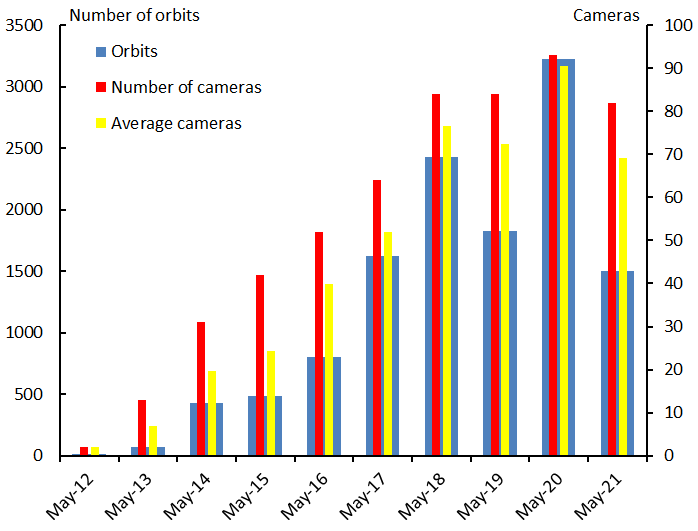
Figure 1 – Comparing May 2021 to previous months of May in the CAMS BeNeLux history. The blue bars represent the number of orbits, the red bars the maximum number of cameras running in a single night and the yellow bars the average number of cameras running per night.
Table 1 – May 2021 compared to previous months of May.
| Year | Nights | Orbits | Stations | Max. Cams | Min. Cams | Mean Cams |
| 2012 | 5 | 13 | 4 | 2 | 2 | |
| 2013 | 13 | 69 | 9 | 13 | 6.8 | |
| 2014 | 22 | 430 | 13 | 31 | 19.7 | |
| 2015 | 25 | 484 | 15 | 42 | 24.2 | |
| 2016 | 26 | 803 | 17 | 52 | 16 | 39.9 |
| 2017 | 24 | 1627 | 19 | 64 | 22 | 52.0 |
| 2018 | 31 | 2426 | 21 | 84 | 64 | 76.6 |
| 2019 | 29 | 1825 | 20 | 84 | 53 | 72.4 |
| 2020 | 29 | 3226 | 24 | 93 | 70 | 90.5 |
| 2021 | 28 | 1503 | 26 | 82 | 51 | 69.2 |
| Total | 232 | 12406 |
3 Conclusion
May 2021 was the poorest month of May since 2016. Although the weather wasn’t exceptionally unfavorable with 28 nights that allowed to collect at least some meteors. A significant decrease in available cameras compared to previous year reduced the chances to record multi-station meteors. This combined with much less favorable weather resulted in less than half the number of orbits for May 2021 compared to 2020.
Acknowledgment
Many thanks to all participants in the CAMS BeNeLux network for their dedicated efforts. The data on which this report is based has been taken from the CAMS website. The data reduction and orbit calculation for all stations is coordinated by Carl Johannink. The CAMS BeNeLux team is operated by the following volunteers:
Hans Betlem (Woold, Netherlands, CAMS 3071, 3702 and 3073), Felix Bettonvil (Utrecht, Netherlands, CAMS 376 and 377), Jean-Marie Biets (Wilderen, Belgium, CAMS 379, 380, 381 and 382), Ludger Boergerding (Holdorf, Germany, RMS 3801), Martin Breukers (Hengelo, Netherlands, CAMS 320, 321, 322, 323, 324, 325, 326 and 327), Guiseppe Canonaco (Genk, RMS 3815), Pierre de Ponthiere (Lesve, Belgium, RMS 3816), Bart Dessoy (Zoersel, Belgium, CAMS 397, 398, 804, 805, 806), Tammo Jan Dijkema (Dwingeloo, Netherlands, RMS 3199), Jean-Paul Dumoulin, Dominique Guiot and Christian Walin (Grapfontaine, Belgium, CAMS 814 and 815, RMS 3814), Uwe Glässner (Langenfeld, Germany, RMS 3800), Luc Gobin (Mechelen, Belgium, CAMS 3890, 3891, 3892 and 3893), Tioga Gulon (Nancy, France, CAMS 3900 and 3901), Robert Haas (Alphen aan de Rijn, Netherlands, CAMS 3160, 3161, 3162, 3163, 3164, 3165, 3166 and 3167), Robert Haas (Texel, Netherlands, CAMS 811, 812 and 813), Kees Habraken (Kattendijke, Netherlands, RMS 378), Klaas Jobse (Oostkapelle, Netherlands, CAMS 3031, 3032, 3033, 3034, 3035, 3036 and 3037), Carl Johannink (Gronau, Germany, CAMS 3001, 3002, 3003, 3004, 3005, 3006, 3007, 3008, 3009 and 3010), Reinhard Kühn (Flatzby, Germany, RMS 3802), Hervé Lamy (Dourbes, Belgium, CAMS 394 and 395), Hervé Lamy (Humain Belgium, CAMS 816), Hervé Lamy (Ukkel, Belgium, CAMS 393), Tim Polfliet (Gent, Belgium, CAMS 396), Steve Rau (Zillebeke, Belgium, CAMS 3850 and 3852), Paul and Adriana Roggemans (Mechelen, Belgium, RMS 3830 and 3831, CAMS 3832, 3833, 3834, 3835, 3836 and 3837), Hans Schremmer (Niederkruechten, Germany, CAMS 803) and Erwin van Ballegoij (Heesch, Netherlands, CAMS 348).


